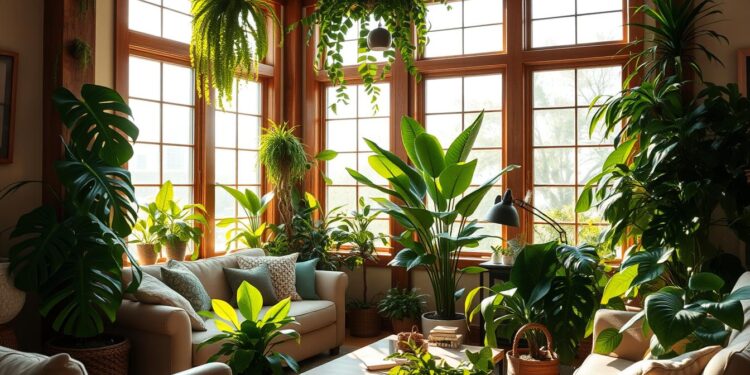Choosing the right living room paintings is key to making your home welcoming. The best artwork shows off your style and boosts your home’s look. Whether you want bold colors or something more elegant, knowing what you like helps. We’ll see how the right art can make your living room a true reflection of you.
Think about what art means to you. This way, you can pick pieces that really speak to you. Let’s dive into why living room art is so important for your space.
Key Takeaways
- Living room paintings create an inviting space that reflects your personality.
- Understanding your style helps in choosing the best living room artwork.
- Artwork can significantly enhance the aesthetic appeal of your home.
- Stylish living room paintings can set the mood and tone of your space.
- Thoughtful selection of paintings can transform your living area.
Understanding the Importance of Artwork in Your Living Room

Artwork is key to making your living room feel special. It’s not just decoration; it shows who you are and your style. The right art can turn your space into a place of emotion and conversation.
Emotional Influence of Art
Art can change how you feel in your living room. It can make the room feel calm or lively. Think about what mood you want to create. A quiet landscape can relax you, while a bold abstract piece can energize the space.
Aesthetic Appeal
Choosing art that looks good with your room is important. The colors and styles of art should match your furniture and walls. This makes your living room look better and feel welcoming.
Reflecting Personal Style
Art is a great way to show your style. The art you pick tells people about your interests and values. Whether you like modern, classic, or eclectic, the right art shows your unique self. It makes your space feel truly yours.
Types of Living Room Paintings

Choosing the right painting for your living room can change everything. Knowing the different types helps you pick pieces that match your style and improve the mood. Here are some popular options, each with its own special features.
Abstract Art
Abstract living room decor stands out with its unique shapes and bright colors. It stirs emotions and sparks conversations, making it perfect for modern spaces. Abstract paintings are great for starting discussions, as they invite everyone to share their thoughts.
Landscape Paintings
Landscape paintings bring nature indoors. They show peaceful outdoor scenes, bringing calm to your room. These paintings can make you feel connected to nature, creating a serene atmosphere in your living room.
Portraits and Figurative Work
Portraits and figurative works add a personal touch. They can show loved ones or famous people, adding depth and character. Including these paintings lets you express your personality and interests, making your room truly yours.
Still Life
Still life paintings highlight everyday objects, showing beauty in the mundane. They add an artistic touch, celebrating the joy of simple things. Adding still life paintings to your room can make it more interesting and engaging.
Choosing the Right Size for Your Space

Finding the perfect size for your wall art is key to improving your living space. It’s important to measure your wall space and match it with your furniture. This helps you pick the right wall art size that adds to your interior without taking over.
Using these tips will help you make smart choices. You’ll find the right size for your large living room wall art and smaller pieces. They will complement your room beautifully.
Measuring Wall Space
Start by measuring your wall’s height and width. Remember to include windows, doors, and special features in your measurements. A good rule is to use 60-75% of the wall’s size for your artwork.
This makes sure your art looks balanced and right.
Scaling with Furniture
Your furniture should help you decide on the art size. Big pieces of art look great above a couch or fireplace. Smaller art works well in small spaces without making it look messy.
Here are some tips:
- Place art above furniture about 6-12 inches up.
- Match the art size with your furniture.
- Don’t mix too many busy pieces; let each one stand out.
Creating Visual Balance
Getting visual balance makes your space look better. Mix different art sizes to keep things interesting. For example, combining various sizes of art creates layers.
Big pieces grab your attention, while small ones provide a calm background.
Color Schemes and How They Matter

The colors in your living room paintings are key to the room’s feel. Picking the right colors can make your space look better and let the art shine. Knowing how colors work together helps you choose the best ones for your room.
Complementing Existing Colors
Think about how the colors in your paintings match your room’s decor. Choose colors that either match or contrast well. A color wheel can help find colors that go well together. This way, your affordable living room art will look like it was meant to be there.
Bold vs. Neutral Palettes
Deciding between bold and neutral colors depends on the mood you want. Bold colors bring energy and draw attention. Neutral colors let other room elements, like furniture, take center stage. Pick art that matches the vibe you want your room to have.
Seasonal Color Considerations
Keeping up with seasonal colors can make your room feel new. Color trends change with the seasons. Switching your art to match these trends keeps your room lively all year.
Style Themes for Living Room Paintings

Choosing artwork for your living room is about matching it with certain styles. These styles help you create a unified look in your space. You can pick from modern art for a clean look, classic styles for tradition, or eclectic decor for a unique vibe.
Modern and Contemporary Themes
Modern living room art adds sophistication and simplicity. Look for pieces with:
- Bold colors and abstract forms
- Minimalist designs with clean lines
- Innovative materials that break the mold
These artworks make your space feel modern and lively.
Classic and Traditional Styles
Classic painting styles are timeless and fit well in many homes. Choose traditional artworks with:
- Detailed landscapes for calmness
- Portraits with historical value
- Still life pieces with rich colors and textures
These elements can make your living room feel rich and cultured.
Eclectic and Bohemian Looks
Eclectic living room decor celebrates diversity and creativity. It’s all about mixing different art styles and colors freely. Consider adding:
- Diverse frame styles and finishes
- Art from various cultures and times
- Unique textures like textiles and 3D art
Where to Display Your Paintings

Choosing the right spots for your artwork can really make your living space look better. Good painting placement ideas can make your room stand out. This part talks about the best places and ways to show off your paintings.
Focal Points and Key Walls
Finding the right spots in your living room is key. These can include:
- Above the sofa
- Near the fireplace
- In an entryway
Make sure your art fits well with the room. It should flow smoothly and show off your style.
Gallery Walls
Gallery walls are a fun way to show off many pieces together. To get a balanced look:
- Choose a theme or color scheme that ties everything together.
- Use different sizes and styles for a unique look.
- Keep the same space between each piece.
This way, you can tell your story through art and create a beautiful display.
Above Furniture Placement
Putting art above furniture can make your room look more put together. Good spots include:
- Above a sideboard or console table
- Over a bed or headboard
- Near accent chairs
Mixing Different Art Styles

Mixing art styles in your living room can make it visually rich. It adds depth and character, making your space lively and welcoming. The trick is to blend elements in a way that looks good together. This creates art collections that show off your style while staying stylish.
Balancing Various Aesthetics
To mix aesthetics well, think about the mood you want. For example, modern and traditional art together can be interesting. Consider how colors and shapes work together in your art. This helps balance your pieces, so they don’t fight for attention.
Cohesion vs. Contrast
It’s important to balance cohesion and contrast. Choose a color scheme that ties everything together for unity. But don’t forget to add contrasts to energize the space. A bold abstract piece can stand out next to classic art. The right mix lets your art enhance each other.
Tips for Effective Mixing
- Choose a theme, like a color scheme or emotion, to guide your art choices.
- Use different sizes and shapes to add interest while keeping harmony.
- Add variety in mediums, like paintings, photographs, or textiles, for texture.
- Switch up your art to keep the space fresh and explore new styles.
Selecting Frames and Mounting Options

Choosing the right frame and mounting options can greatly affect how your living room paintings are perceived. Frames enhance the artwork, adding a finishing touch and reflecting your personality and style. Here’s what you need to know about different frame materials and styles, the importance of matting, and ideal hanging heights.
Frame Materials and Styles
When it comes to framing paintings, various materials and styles are available to suit your décor. Here are some popular options:
- Wood Frames: Classic and versatile, they can add warmth to any piece.
- Metal Frames: Ideal for modern or industrial themes, offering sleek lines and a contemporary touch.
- Acrylic Frames: Lightweight and trendy, perfect for a minimalist look.
- Gallery Frames: Typically wide and deep, these frames create a dramatic impact for larger art pieces.
Importance of Matting
Matting can elevate your artwork by providing contrast and dimension. It serves several purposes, including:
- Enhancing Visibility: Matting draws attention to the artwork itself rather than distracting from it.
- Protection: It prevents the artwork from coming directly into contact with the glass, reducing the risk of damage.
- Creating a Sense of Space: Matting can help set the artwork apart from the wall, giving it room to “breathe.”
Hanging Height and Placement
The placement and height of your framed artworks play a significant role in their overall appearance and impact. Here are some tips for effective hanging:
- Eye Level: Hang artwork at eye level for optimal viewing, usually around 57 to 60 inches from the floor.
- Groupings: When creating gallery walls, keep the center of the grouping at eye level and arrange pieces with a cohesive theme.
- Above Furniture: Leave about 6 to 12 inches of space above furniture like sofas and consoles to create a balanced look.
Shopping for Living Room Paintings

Looking for living room paintings? You have many places to choose from, each with its own benefits. You can visit local art galleries, shop online, or check out art fairs. Knowing these options helps you find the perfect piece that fits your style and budget.
Local Art Galleries
Local art galleries let you meet artists and see their work up close. This personal connection makes the art more meaningful. Plus, you support local artists and see new pieces with each visit.
Online Marketplaces
Shopping online for art is convenient and offers a wide range of choices. You can find paintings in many styles and prices. Just make sure to read reviews and check return policies for a good buying experience.
Art Fairs and Exhibitions
Art fairs and exhibitions are lively places to find new art. You’ll see many paintings and can talk to the artists. This gives you a deeper understanding of the art and the artists’ inspirations.
| Shopping Option | Advantages | Considerations |
|---|---|---|
| Local Art Galleries | Direct interaction with artists, supports local community, unique selections | Limited inventory, potentially higher prices |
| Online Marketplaces | Wide selection, convenience, potential for lower prices | No tactile experience of the artwork, check return policies |
| Art Fairs and Exhibitions | Diverse options, opportunity to meet artists, dynamic environment | Occasional crowds, may require travel |
Budgeting for Artwork

Buying artwork needs careful thought. You must understand the value of art, like original vs. reproduction paintings. Art can be very valuable, but setting a budget helps find great pieces without spending too much. Affordable art can make your living room beautiful while keeping costs down.
Understanding Art Valuation
Art valuation looks at many things, like the artist’s fame, the piece’s uniqueness, and demand. Knowing these helps figure out the right price for your art. Talking to art appraisers or researching can help understand different pieces’ values. This helps you budget better for your living room art, making smart choices.
Choosing Between Originals and Reproductions
When looking at art, you might think about original vs. reproduction paintings. Originals are pricier because they’re real and by the artist. Reproductions are cheaper, letting you enjoy similar looks without spending a lot. Think about what you want and what you can afford to choose the best for you.
Tips for Affordable Art
- Explore local art fairs and exhibitions for reasonably priced pieces.
- Consider emerging artists whose work may be available at lower prices.
- Look for online marketplaces that specialize in affordable living room artwork.
- Set a clear budget and track your spending while shopping.
- Keep an eye out for seasonal sales or promotions.
Maintenance and Care for Art

Keeping your living room paintings beautiful is crucial. Using the right art care tips can make your artworks last longer. Here are key strategies for maintaining paintings, protecting them from damage, and creating a good environment.
Cleaning and Dusting Techniques
Cleaning your artwork regularly is important. Use a soft, dry cloth or a microfiber duster to gently remove dust. Avoid harsh chemicals that can harm your artwork. If unsure, check specific cleaning advice for your painting’s medium.
- Oil paintings can be wiped lightly with a clean, dry cloth.
- Acrylic paintings may need a damp cloth, but ensure no moisture seeps into the frame.
- Framed pieces with glass can be cleaned with glass cleaner; just avoid the painting itself.
Protecting from Sunlight
Sunlight can fade colors and damage your artwork. Here are steps to protect your wall art:
- Hang artworks away from direct sunlight.
- Use UV-filtering glass or acrylic for framing.
- Consider closing curtains or using shades when the sun’s intensity is high.
Climate Control
Keeping a stable climate is key for your paintings’ longevity. Too much humidity can cause mold, while too little can lead to cracking. Follow these tips:
- Keep artwork in a climate-controlled environment.
- Avoid placing paintings near heating or cooling vents.
- Monitor humidity levels with a hygrometer and aim for levels between 40-60%.
Supporting Local Artists

Buying art from local artists is a win-win for everyone. It makes your community more vibrant and your home more special. Local art tells the stories and traditions of the area, connecting you to it deeply.
Benefits of Local Artwork
Choosing local art has many perks:
- Cultural Enrichment: It shows off your area’s heritage and diversity.
- Economic Impact: It helps keep jobs and boosts the local economy.
- Unique Creations: Original pieces make your space stand out from the rest.
- Community Connection: Art links you to shared stories and experiences.
Finding Local Talent
Finding local artists is an adventure. Here’s how to start:
- Check out local art galleries and exhibitions.
- Go to art fairs to see different artists’ work.
- Look at online platforms that highlight local artists.
By looking for local talent, you can find art that fits your style and supports local artists.
Community Art Projects
Joining community art projects strengthens your bond with local culture. These projects might include:
- Community murals that change public areas.
- Joint installations that bring people together.
- Workshops by local artists to spark creativity.
Getting involved in community art not only makes your area look better. It also makes you feel like you belong. Supporting local artists builds a creative and collaborative community spirit.
Incorporating Personal Touches
Your living room can show off your life and family history with personal artwork. Adding family heirlooms makes your space more meaningful. Each piece of art or decor shares a story, turning your home into a vibrant showcase of memories.
Family Heirlooms and Personal Creations
Using family heirlooms in your decor honors your heritage and adds a unique touch. Display items like paintings or sculptures that remind you of family memories. You can also add personal creations, like handmade crafts or photos, to make your space even more special.
Custom Artwork Ideas
Custom art for your living room lets you express your unique style. Work with local artists or online platforms to create pieces that fit your taste. Choose colors and themes that match your decor. This way, your artwork truly reflects you.
Storytelling Through Art
Art is a powerful way to tell stories. Each piece you choose can share feelings, memories, and experiences. Create a gallery with family heirlooms and custom artwork to tell your story. This thoughtful arrangement will spark conversations and warm up your living room.
Painting Trends to Consider
Refreshing your living room? Knowing the latest art trends is key. Lately, bold abstracts and soothing landscapes are big. These styles, brought to life by top artists, add color and texture to any room.
Popular Styles in Recent Years
Minimalism is back, with its focus on simplicity and neutral colors. But, bold and expressive art is also popular. The goal is to pick a style that feels right to you, making your space welcoming.
Artists to Watch
Look out for new artists making waves. Jennifer Pochinski and Tamara de Lempicka are among them. Their work is both bold and timeless, perfect for sparking conversations in your home.
Seasonal Trends in Living Room Art
Art trends change with the seasons. Light colors and flowers are in during spring and summer. But, fall and winter bring warmer, richer tones. Switching art with the seasons keeps your room fresh and stylish.














